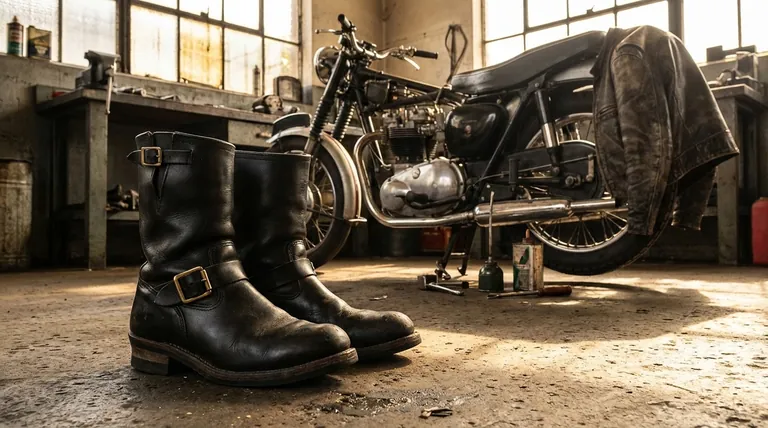In postwar culture, engineer boots transformed from specialized workwear into a powerful symbol of rebellion. This evolution was driven by the rise of veteran motorcycle clubs and cemented by Hollywood icons like Marlon Brando, who adopted the boot for both its practical function and its rugged aesthetic.
The engineer boot’s journey from utility to icon was not an accident. Its laceless, protective design was perfectly suited for the burgeoning motorcycle culture, while its adoption in film gave it a permanent place as a symbol of American non-conformity.

From the Railyard to the Open Road
The story of the engineer boot's cultural ascent begins with the unique circumstances following World War II.
The Post-War Catalyst
After a production hiatus during the war, engineer boots returned to the market. They found a new audience in former servicemen who formed motorcycle clubs, often riding surplus military bikes.
A Perfect Match for the Motorcycle
This pairing was based on pure function. The boot's signature design—a tall, laceless leather shaft with ankle and top buckles—offered critical protection for riders.
The lack of laces prevented them from getting caught in a motorcycle's drive chain or belt. The heavy leather also provided insulation from engine heat and shielded the rider's leg during a fall.
Cemented in Culture: The Rise of the Rebel Icon
While motorcycle clubs established the boot's practical credentials, Hollywood made it a legend.
The Brando Effect
The 1953 film The Wild One was the turning point. Marlon Brando's portrayal of a charismatic biker gang leader, clad in a leather jacket and engineer boots, instantly defined the "rebel" look for a generation.
This image, alongside similar styles adopted by figures like James Dean, turned the boot into a visual shorthand for a tough, anti-establishment attitude.
A Symbol of Non-Conformity
In the buttoned-down culture of the 1950s, the engineer boot was a clear statement. Its rugged, utilitarian form stood in stark contrast to the polished dress shoes of mainstream society, making it the footwear of choice for burgeoning youth counter-cultures.
The Decline and Resurgence
The boot's journey was not a straight line. As its popularity peaked, its original purpose was often diluted.
The Quality Crisis of the 1970s
Widespread popularity led many manufacturers to prioritize volume over quality. During the 1970s, the market was flooded with poorly made versions of the boot that lacked the durability of the originals.
The Return to Authenticity
The engineer boot's legacy was reclaimed in the late 1990s and 2000s. A renewed interest in vintage Americana and heritage workwear led brands to revive the authentic, high-quality designs of the past, re-establishing the boot's reputation for toughness and style.
The Enduring Legacy of the Engineer Boot
To understand the engineer boot, you must see it through multiple lenses.
- If your primary focus is its functional roots: Its adoption by post-war motorcyclists for practical safety is the definitive origin of its modern identity.
- If your primary focus is its cultural impact: Its appearance in 1950s cinema, particularly on Marlon Brando, is what elevated it from workwear to a symbol of rebellion.
- If your primary focus is its modern form: Its resurgence is tied to heritage-focused brands that revived the authentic, high-quality construction that first made it famous.
Ultimately, the engineer boot endures because its story is a perfect fusion of practical design and powerful symbolism.
Summary Table:
| Era | Key Development | Impact on Engineer Boots |
|---|---|---|
| Post-WWII | Surplus bikes & veteran motorcycle clubs | Adopted for practical safety (no laces, heat protection) |
| 1950s | Hollywood films like The Wild One | Became a symbol of rebellion and non-conformity |
| 1970s | Mass production & popularity surge | Quality decline with poorly made versions flooding the market |
| 2000s+ | Heritage and vintage Americana trend | Resurgence of authentic, high-quality designs and construction |
Inspired by the enduring legacy of the engineer boot?
As a large-scale manufacturer, 3515 produces a comprehensive range of authentic, high-quality footwear for distributors, brand owners, and bulk clients. Our production capabilities encompass all types of durable boots, including heritage styles built to last.
Partner with us to bring authentic, well-crafted footwear to your market.
Contact us today to discuss your manufacturing needs!
Visual Guide

Related Products
- Wholesale Safety Footwear Manufacturer for Bulk & Custom OEM Orders
- Premium High-Cut Waterproof Safety Boots Manufacturing & Wholesale Solutions
- Wholesale Anti-Smash & Puncture-Proof Safety Shoes Custom Manufacturing for Brands
- Premium Wholesale Wheat Nubuck Safety Boot with Rapid Lacing System
- Custom Wholesale Leather Safety Boots Direct Factory Manufacturing
People Also Ask
- Is safety toe better than steel toe? A Guide to Choosing the Right Protection
- Why is the last important in work boot design? It's the Anatomical Blueprint for Comfort & Safety
- How do safety shoes contribute to cost savings for companies? A Strategic Investment in Risk and Cost Management
- Is there a downside to steel toe boots? Weighing Protection Against Daily Comfort
- Do moc toe boots have steel toe? Get Durable, Safety-Compliant Footwear



















